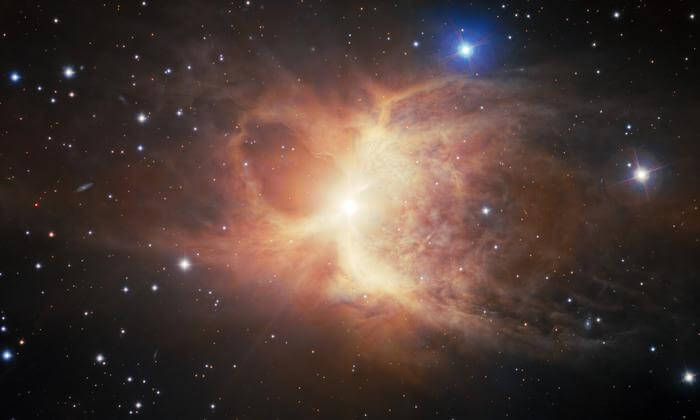Astronomers have made a remarkable discovery in the form of a rare reflection nebula known as IC 2220, affectionately called the Toby Jug Nebula due to its resemblance to an ancient English drinking vessel.
Situated approximately 1200 light-years away in the Carina constellation, this nebula is characterized by its double-lobed structure composed of gas and dust. The nebula owes its luminosity to a red-giant star positioned at its core, which both creates and illuminates the celestial cloud. Such formations are scarce and provide a unique opportunity for scientists to examine stellar evolution.
An image of the Toby Jug Nebula, taken by the Gemini South telescope, part of the International Gemini Observatory managed by the National Science Foundation’s NOIRLab, showcases the nebula’s exquisite double-looped structure and its radiant stellar heart. These features are specific to red giants transitioning from aging stars to planetary nebulae, offering valuable insights into the development of low- to intermediate-mass stars nearing the end of their life cycle, as well as the cosmic structures they give rise to.
At the center of the Toby Jug Nebula lies its progenitor, a red-giant star named HR3126. Red giants are formed when a star depletes its hydrogen fuel in its core, causing it to contract. This process raises the core temperature, causing the star to expand up to 400 times its original size. Despite being considerably younger than our Sun, at only 50 million years old compared to the Sun’s 4.6 billion years, HR3126 possesses five times the mass. This allowed it to exhaust its hydrogen supply and transform into a red giant more rapidly than our Sun.
As HR3126 expanded, its atmosphere enlarged and began shedding its outer layers. The expelled stellar material dispersed into the surrounding space, forming a magnificent structure comprising gas and dust that reflects the light emitted by the central star. Detailed studies conducted in infrared light have identified silicon dioxide (silica) as the most probable compound responsible for reflecting HR3126’s light.
Astronomers propose that bipolar structures akin to those observed in the Toby Jug Nebula are the outcome of interactions between the central red giant and a binary companion star. However, previous observations failed to detect such a companion to HR3126. Instead, scientists identified an incredibly compact disk of material surrounding the central star. This finding suggests that a former binary companion may have been torn apart, giving rise to the disk and potentially triggering the formation of the surrounding nebula.
In approximately five billion years, our own Sun will undergo a similar transformation. Once it depletes its hydrogen fuel, it will evolve into a red giant and eventually transition into a planetary nebula. In the far future, all that will remain of our Solar System will be a vibrant nebula resembling the Toby Jug Nebula, with the cooling Sun at its core.
The image of the Toby Jug Nebula was processed by NOIRLab’s Communication, Education & Engagement team as part of the NOIRLab Legacy Imaging Program. Observations were made using the Gemini South telescope on Cerro Pachón in Chile, employing one of the dual Gemini Multi-Object Spectrographs (GMOS). While spectrographs are primarily designed to analyze light across various wavelengths, the GMOS spectrographs also possess exceptional imaging capabilities, as demonstrated by this remarkable depiction of the Toby Jug Nebula.
For additional information, please refer to the following source:
[1] The term “planetary nebulae” is a misnomer, as they are unrelated to planets. The term was likely coined in the 1780s by astronomer William Herschel, who observed their seemingly spherical, planet-like shape through early telescopes.

